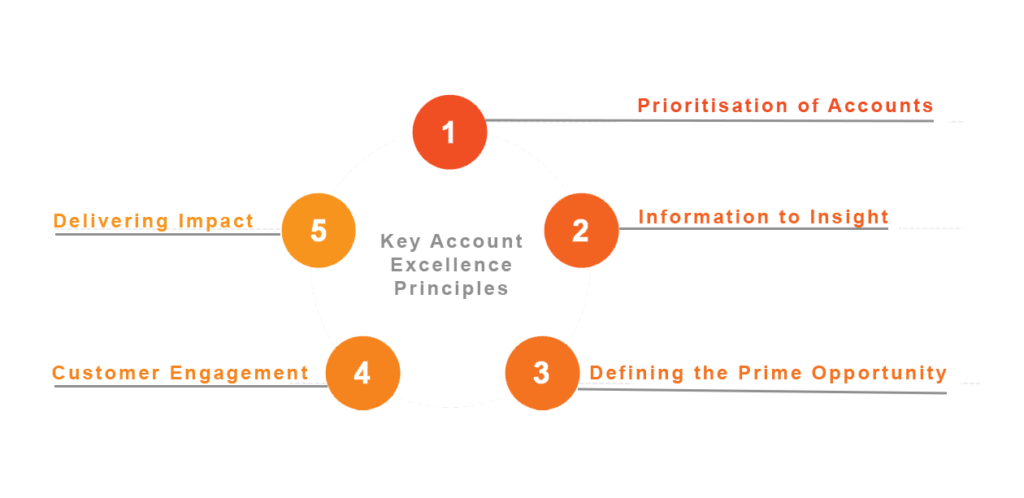
As the health provider landscape undergoes radical change and traditional ways of doing business lose traction, Key Account Excellence is now widely accepted as the way forward for the pharmaceutical industry. Making it happen, however, is another matter.
With over 20 years’ experience as an organisational change consultancy to some of the sector’s major players and drawing on our bank of data from pharmaceutical companies around the world, Rubica has developed a structured programme and Key Account Excellence Framework that offers a practical and proven response to overcoming the challenges associated with achieving Key Account Excellence.
In our first three articles, we introduce the first principle (see Fig. 1) of Rubica’s Key Account Excellence Framework – the Prioritisation of Accounts.
Fig.1

The key account management process
The Prioritisation of Accounts is a filtering process to help teams identify the key customers who are open to a much closer and mutually beneficial relationship with your business.
Are they customers that you can work with productively and support even better? Do your products and therapies have a particular match with their patients’ needs? Your final choice should always be one that benefits all three partners in the relationship – your company, the customer and the patient.
It’s important to note that, as part of this process, you shouldn’t be looking to change the way you work with all your customers, even if you could. You may have active and valuable accounts that can be maintained and improved without any radical changes to the relationship. At least, for the moment.
The challenge: Getting your rationale right
The key challenge with Prioritisation of Accounts is establishing a clear understanding of why these accounts have been prioritised.
Building a clear rationale is therefore imperative for three main reasons:
- Changing the way you work with a customer involves a serious investment of time, energy and resources. You can’t afford to do it for every account. So, you need to be certain that you are making the right choices i.e. working with accounts where the results are likely to be worthwhile.
- To achieve true Key Account Excellence you need cross-functional team support, so engagement and commitment at every level are essential. You need to make a convincingly argued case that will persuade everyone to play their part to the full.
- Finally, a clear rationale will help you to focus on the practicalities – identifying needs and opportunities that are currently unmet and setting a direction for future account activity.
Building a clear rationale – where to begin?
Winning hearts and minds
Building a clear rationale requires a change in behaviour and change often encounters resistance. Salespeople are used to being handed the marketing strategy, segments and accounts and told where to concentrate their efforts. Now you are asking them to adopt a whole new mind-set and way of working.
These are busy, time-poor people, and it can be tempting to simply impose new ways of working. The response, however, is likely to be half-hearted at best and you need their engagement and commitment.
To win their confidence and support, you have to convince them of the necessity for change and get them involved as they explore, clarify and pass comment.
Inspire confidence and change behaviour
Be precise. A generalised commercial ambition is not a good enough rationale for your prioritised accounts. “We want more doctors to trial our products!” Of course, you do but why these accounts and why change the way you service them?
Paint a picture of key accounts that’s information-rich and grounded in reality, not assumptions. Explain the outcomes you expect from evolving existing relationships.
Articulating and sharing your rationale will prepare your salesforce for change. It will help them to move away from a reliance on traditional success metrics and tactics and focus on different outcomes.
It can also fundamentally shape beliefs and self-belief. And that matters. It’s vital that they see the potential for real change and feel that they can make a difference, even if they have worked on the same account for years.
Make it a conversation. Whilst promoting awareness and understanding, encourage a wider and deeper engagement with the proposed changes. Make it clear that you value honest opinions and are listening to what they have to say. Engaging in open dialogue is part of the change process, not just a briefing!
Local workshops are a good platform for exploring intended changes together. Critical thinking exercises will allow people to interrogate the proposals and consider their agreement or disagreement. Include a semi-formal mechanism to gather feedback, positive or negative, from the cross-functional or local team. And signpost it clearly, so that they know exactly where to leave comments.
The investment of their own time and energy in the changes will encourage a more positive and engaged way of working in your team. A deeper level of understanding will enable them to notice when things are going well and to raise concerns or suggest changes if they are not. And, as we will see in our future articles, remaining flexible is a key element of maintaining Key Account Excellence.
 Paul Frith -
Paul Frith - 




